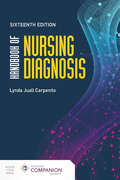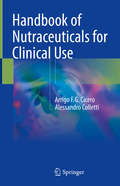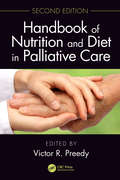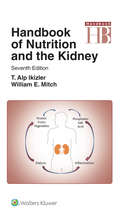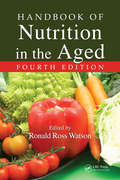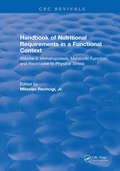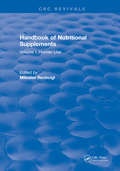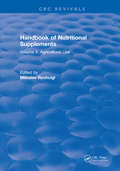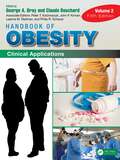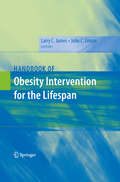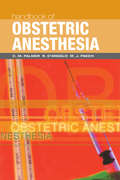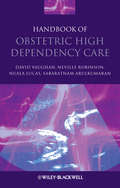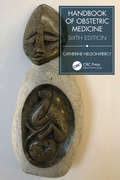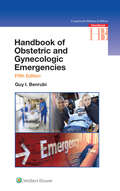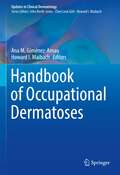- Table View
- List View
Handbook of Nursing Diagnosis
by Lynda Juall CarpenitoLynda Carpenito’s best-selling, Handbook of Nursing Diagnosis, now in an impressive sixteenth edition, is the ideal quick reference for nursing diagnosis information. This trusted handbook covers the NANDA-I Nursing Diagnoses 2021-2023 and offers practical guidance on nursing diagnoses and associated care. The quick-reference type scope of content makes it easy for students to use while in clinical, in the classroom or simulation lab. From goals to specific interventions, Handbook of Nursing Diagnosis focuses on nursing. It provides a condensed, organized outline of clinical nursing practice designed to communicate creative clinical nursing. It is not meant to replace nursing textbooks, but rather to provide nurses who work in a variety of settings with the information they need without requiring a time-consuming review of the literature. It will assist students in transferring their theoretical knowledge to clinical practice.
Handbook of Nutraceuticals and Functional Foods
by Robert E.C. Wildman and Richard S. BrunoThe field of functional foods along with their bioactive food components has grown tremendously over the past decades. Often guided by hypothesis-generating epidemiological observations, discoveries from basic science studies and controlled trials in humans have provided critical evidence to help establish an optimal diet that alleviates chronic disease risk. These advances have also driven efforts by the food and nutraceutical industries to establish and market health claims, formulate extra-value foods, and even generate new health foods for human benefit.Handbook of Nutraceuticals and Functional Foods, Third Edition, compiles the data from experts in the field that potentiates the already established credibility of the earlier editions. In its three-section format, it provides an authoritative summary of the prophylactic and/or medicinal benefits of natural foods and their constituents that are linked to favorable health outcomes. Beginning with an overview of the field and associated regulations, each chapter describes the chemical properties, bioactivities, dietary sources, and evidence of these health-promoting dietary constituents.Features:• Summarizes plant- and animal-based functional foods and their bioactive components• New chapters on cannabidiol and scientific, legal, and regulatory considerations; green tea and nutraceutical applications; and herbal nutraceuticals and insulin resistance• Includes information on functional food beverages including coffee, green tea, and dairy milk• Discusses antioxidant and anti-inflammatory activities of vitamin E, anthocyanins and other (poly)phenolic compounds, and carotenoids• Provides an update on the health benefits and requirements of protein and performance and therapeutic application and safety of creatine.
Handbook of Nutraceuticals for Clinical Use
by Alessandro Colletti Arrigo F.G. CiceroThis handbook provides key information on the clinical use of nutraceuticals, an increasingly common practice grounded in an understanding of the pharmacological activities of natural compounds and clinical evidence of efficacy and safety. Each chapter examines the effects of nutraceuticals in different therapeutic contexts, including nutraceuticals active on the digestive system, heart, lipid and glucose metabolism, and immune system. The authors also address relevant concerns such as relative and absolute contraindications, range of tested doses (efficacious and safe), possible side effects and pharmacological interactions, and the scientific level of clinical evidence for each product. Despite the availability of a large number of nutraceuticals on the market, the same compound is often offered by different industries at different dosages and concentrations, with different titration and often with different suggestions of efficacy. Available academic books on nutraceuticals prioritize summarizing information or focus on the pharmacological aspects on cells or animals models rather than on proof in humans.The handbook takes a unique and practical approach intended to assist clinicians, pharmacologists, nutritionists, and dietitians considering prescribing nutraceuticals for therapeutic use. Renowned expert Professor Arrigo Cicero is known internationally for his work in nutraceuticals, and currently serves as President of the Italian Nutraceutical Society.
Handbook of Nutrition and Diet (Food Science and Technology)
by Babasaheb B. DesaiThis handbook of nutrition and diet provides information on food nutrients and their functions; food safety and distribution; food composition, consumption and utilization; adequacy of diet; and the nutritional management of diseases and disorders. It also discusses the effects of nutrition and diet on diseases of the bones, teeth, hair, kidneys, l
Handbook of Nutrition and Diet in Palliative Care, Second Edition
by Victor R. PreedyHandbook of Nutrition and Diet in Palliative Care, Second Edition, is a comprehensive guide, providing exhaustive information on nutrition and diet in terminal and palliative care. It covers physical, cultural and ethical aspects, bridging the intellectual divide in being suitable for novices and experts alike. Following in the tradition of its predecessor, chapters contain practical methods, techniques, and guidelines along with a section on applications to other areas of palliative care. Each chapter features key facts highlighting important areas, summary points, and ethical issues. FEATURES • Use of cannabinoids in palliative nutrition care • Pain control in palliative care • Communications in palliative/end-of-life care: aspects of bad news • Anorexia in cancer: appetite, physiology, and beyond • Palliative care in severe and enduring eating disorders • Linking food supplementation and palliative care in HIV • Eating-related distress in terminally ill cancer patients and their family members • Palliative care of gastroparesis • Preoperative nutrition assessment and optimization in the cancer patient • Childhood leukemia, malnutrition, and mortality as components of palliative care • End-of-life decisions in persons with neurodevelopmental disorders • Resources: listing web sites, journals, books and organizations
Handbook of Nutrition and Food
by David Heber Johanna T. Dwyer Carolyn D. BerdanierThe new edition of the Handbook of Nutrition and Food follows the format of the bestselling earlier editions, providing a reference guide for many of the issues on health and well being that are affected by nutrition. Completely revised, the third edition contains 20 new chapters, 50 percent new figures. A comprehensive resource, this book is a reference guide for many of the issues on health and well being that are affected by nutrition. Divided into five parts, the sections cover food, including its composition, constituents, labeling, and analysis; nutrition as a science, covering basic terminology, nutritional biochemistry, nutrition and genetics, food intake regulation, and micronutrients; nutrient needs throughout the human life cycle; assessment of nutrient intake adequacy; and clinical nutrition, from assessments to a wide variety of disease and health topics.
Handbook of Nutrition and Pregnancy (Nutrition and Health)
by Carol J. Lammi-Keefe Sarah C. Couch John P. KirwanThis easy to use text provides practitioners and researchers with a global view of current and emerging issues concerned with successful pregnancy outcomes and approaches that have been successful or show promise in ensuring a successful pregnancy. The fully updated and revised second edition expands its scope with topics not covered in the first edition including pregnancy and military service; sleep disorders during pregnancy; the gut microbiome during pregnancy and the newborn; requirement for vitamin D in pregnancy; the environment—contaminants and pregnancy; preeclampsia and new approaches to treatment; health disparities for whites, blacks, and teen pregnancies; depression in pregnancy—role of yoga; safe food handling for successful pregnancy outcome; relationship of epigenetics and diet in pregnancy; caffeine during pregnancy; polycystic ovary syndrome; US Hispanics and preterm births; celiac disease and pregnancy; cannabis use during pregnancy.The second edition of Handbook of Nutrition and Pregnancy will be a valuable resource for clinicians and other healthcare professionals who treat and counsel women of child-bearing age and pregnant women.
Handbook of Nutrition and the Kidney (Lippincott Williams & Wilkins Handbook Series)
by William E. Mitch T. Alp IkizlerRevised and updated by experts in both nephrology and clinical nutrition, this seventh edition of Handbook of Nutrition and the Kidney provides practical and clinically relevant information for addressing the nutritional needs of patients with acute and chronic kidney disease. Concise yet in-depth, the book is packed with tables and charts in every chapter, and outlines detailed and daily nutritional requirements, including proteins, vitamins, minerals, lipids, other fatty acids, and more.
Handbook of Nutrition in the Aged
by Ronald Ross WatsonDetailed Review of Nutritional Therapies Used to Combat Elderly Health IssuesThe combination of the aging baby-boomer generation and their increased longevity has been fortunately met with increased research and greater understanding of health promotion and disease prevention in the elderly. Handbook of Nutrition in the Aged: Fourth Edition shares
Handbook of Nutritional Disorders
by Jahangir Moini Katia FerdowsiHandbook of Nutritional Disorders is a comprehensive handbook covering topics in nutrition, malnutrition, and the clinical disorders associated with nutrition from deficiency to toxicity. It includes information on disorders related to carbohydrate, lipid, and protein metabolism as well as vitamin and mineral abnormalities. The book details various types of supplements, feeding methods, and therapies for many specific patients. It aims to educate readers on ways to prevent disorders resulting from all types of malnutrition and their potentially severe complications.Features Strong focus on diabetes featuring information on various forms of the disease and treatment information Detailed discussion of lipids and related disorders – cardiovascular disease is the number one cause of death, informs users on prevention and treatment of hypertension, myocardial infarction, and stroke Contains information on selective nutritional disorders including obesity, dehydration, imbalances, malabsorption, alcoholism, neuropsychiatric disorders, eating disorders, cancer, and pollutant poisonings Written for researchers, academia, and students in healthcare and nutrition fields, this book educates individuals on prevention of disorders resulting from all types of malnutrition and their potentially severe complications.
Handbook of Nutritional Requirements in a Functional Context: Volume I: Development and Conditions of Physiologic Stress
by Miloslav RechciglThe purpose of this Handbook is to bring together all the available information on the nutritional requirements of animal organisms for specific processes and functions. This is believed to be the first systematic treatment of nutrition in a functional context. Apart from furnishing specific nutritional data, this Handbook provides a useful framework for a comparative physiologist or biochemist searching for commonality or idfferences among various biological systems.
Handbook of Nutritional Requirements in a Functional Context: Volume II, Hematopoiesis, Metabolic Function, and Resistance to Physical Stress
by Miloslav RechciglThe purpose of this Handbook is to bring together all the available information on the nutritional requirements of animal organisms for specific processes and functions. This is believed to be the first systematic treatment of nutrition in a functional context. Apart from furnishing specific nutritional data, this Handbook provides a useful framework for a comparative physiologist or biochemist searching for commonality or idfferences among various biological systems.
Handbook of Nutritional Supplements: Volume I: Human Use (Crc Series In Nutrition And Food)
by Miloslav RechciglThe Handbook is composed of two parts, the first volume covering supplements for human usewhile the second volume is devoted to agriculture supplements. This volume, relating to food supplements for human use, is organized on the basis of raw materials utilized in their production, as well as on the basis of target groups for which they are intended.
Handbook of Nutritional Supplements: Volume II, Agricultural Use
by Miloslav RechciglThe Handbook is composed of two parts, the first volume covering supplements for human usewhile the second volume is devoted to agriculture supplements. This volume, relating to agriculture supplements, covers various food byproducts and nutritional and other food supplements used in animal feeding. In addition, it also includes information on nutrition supplements for plants.
Handbook of Nutritionally Essential Mineral Elements (Clinical Nutrition in Health and Disease)
by Boyd L. O’Dell Roger A. Sunde"Offers comprehensive, definitive information on all of the essential mineral elements--focusing on biochemical and physiological processes. Describes in detail the function of the nutritionally necessary elements revealed through the latest techniques in molecular biology as well as traditional research methods."
Handbook of Nutritive Value of Processed Food: Volume 1: Food for Human Use (Routledge Revivals)
by Miloslav RechciglFirst published in 1982: This publication should be an invaluable tool to food technologists, dieticians, and nutritionalists, as well as to livestock producers and persons engaged in production, processing, and formulation of animal feeds.
Handbook of Obesity - Volume 1: Epidemiology, Etiology, and Physiopathology
by George A. BrayThe fifth edition of Volume 1 of Handbook of Obesity written by global experts covers the basic science aspects under the broad topic areas of epidemiology, etiology, and pathophysiology of obesity. Divided into 5 sections and detailed in 66 chapters, this edition covers the important advances occurring over the past decades. With a focus on science of obesity and factors participating in the etiology of obesity, this topic is studied from biological, behavioural, and environmental perspectives. Volume 1 is structured into 5 parts: Part 1 focuses on the history, definitions, and prevalence of the obesity. It identifies the historical references to excess weight, obesity in art and literature, direct and surrogate measurements of adiposity and obesity related traits, epidemiology of obesity around the globe, and age, sex, and ethnic variation completes this part of the volume.Part 2 explains the biological determinants of obesity. It explains the bioenergetics, energy dissipation mechanisms and exposure to experimental overfeeding, genetic and epigenetic evidence, metabolic rates, energy expenditure and energy partitioning, and the evidence on infections and adiposity.Part 3 describes the behavioral determinants of obesity. It deals with chapters related to food, beverages, and ingestive behavior, dealing with smoking, breast-feeding, and sleep duration and pattern, and sedentary behavior, occupational work, and leisure-time physical activity and obesity.Part 4 comprises of chapters explaining the environmental, social, and cultural determinants of obesity. The chapters in this section focus on the role of agriculture and the food industry in the current obesity epidemic, social and economic aspects of obesity, and ethnic and cultural differences, and environmental pollutants.Part 5 of this volume discusses the health consequences of obesity. The chapters address important topics such obesity and heart disease, lipoprotein metabolism, insulin resistance and diabetes, metabolic syndrome, cancer, hepatic biology, pulmonary functions, and arthritis and gout, mental health and quality of life, growth and health disorders in pediatric populations, and on bias and discrimination affecting the obese persons.
Handbook of Obesity - Volume 2: Clinical Applications
by George A. BrayVolume 2 of the 5th Edition of the Handbook of Obesity spotlights on clinical applications for evaluation, diagnosis, prevention, and treatment of obesity. It covers on the several major developments occurred between the previous and the new edition, including the effect of SARS-CoV-2 on people with obesity, the concept of “Precision Medicine”, and new medications approved by USFDA aiding patients with obesity weight loss of 15 to 20%. This volume is structured into 5 parts:Part 1 provides insights from evolution on changes in diet and physical activity, and the implications and results for preventing obesity, health care costs associated with obesity and the cost-effectiveness of obesity prevention and treatment.Part 2 deals with evaluation of overweight patients, approaches for classifying obesity and using this knowledge to evaluate patients, and addressing ethnic and racial considerations in evaluating patients with obesity.Part 3 explains the impact of lifestyle in managing obesity, which include behavioural management, diet, dietary composition, and meal timing, and the effects of physical activity and exercise in weight loss and weight loss maintenance.Part 4 is focused on medications in the management of obesity. This includes drug selection, various classes of drugs, combination of drugs affecting weight loss, effect of herbal agents on weight loss and treatment of obesity in pediatric populations, genetic diseases causing obesity and the role of drugs in treating the dyslipidemias.Part 5 discusses bariatric surgery, its history, procedure and effects in details, and other surgical techniques including electric stimulation of the vagus nerve, gastric balloons, intestinal liners, and liposuction.
Handbook of Obesity Intervention for the Lifespan
by Larry James John C. LintonEnvironmental, genetic, psychological, and societal factors interact to produce obesity, a chronic condition of epidemic proportions. The Handbook of Obesity Intervention for the Lifespan guides professionals in meeting this complex challenge with a multidisciplinary palette of evidence-based interventions that can be tailored to men and women across the lifespan, regardless of background. This unique reference combines salient research data and hands-on clinical applications for use with overweight patients, from the very young to the very old, and includes a "treatment resources" section with extra materials to bolster therapy--all geared toward respectful, encouraging treatment and lasting weight-loss results.
Handbook of Obstetric Anesthesia
by Craig M. Palmer Michael J. Paech Robert D’AngeloThis extensively illustrated book provides an accessible and up-to-date introduction to obstetric anaesthesia and analgesia. With only three principal authors, there is a consistency of style within a comprehensive textbook that presents the basic science, pharmacology and clinical practice relevant to obstetric anaesthesia. Chapters cover topics s
Handbook of Obstetric High Dependency Care
by Sabaratnam Arulkumaran Neville Robinson Nuala Lucas David VaughanConcise practical guidance to managing an Obstetric High Dependency unit The team and clinical environment is the starting point for the Handbook of Obstetric High Dependency Care. The book discusses the structure and requirements of a unit, both clinically and in terms of equipment, protocols and management aims. The main sections cover the investigation, diagnosis and management of clinical disease resulting from pregnancy and incidental to it.
Handbook of Obstetric Medicine
by Catherine Nelson-PiercyMedical professionals are often involved in the management of the pregnant patient without necessarily being experts on all the complications surrounding pregnancy. The Handbook of Obstetric Medicine addresses the most common and serious medical conditions encountered in pregnancy, including heart disease, thromboembolism, diabetes, skin problems, gastrointestinal disease, neurological problems, hormonal diseases, hypertension and pre-eclampsia, and more. For each condition, the handbook includes a description of incidence, clinical features, pathogenesis, diagnosis, the effect of pregnancy, and management of the condition. The book also includes a detailed section focusing on the differential diagnosis of common symptoms including hypertension, chest pain, palpitations, breathlessness, headaches, dizziness, abdominal pain, and more. The symptoms and differential diagnoses are presented in an easy-to-read tabular format and include a description of important clinical features and potential areas of investigation. For those clinicians understandably reluctant to prescribe drugs during pregnancy, a useful appendix includes a section on prescribing in pregnancy and a list of contra-indicated drugs. In addition, to assist in the interpretation of laboratory tests, a second appendix lists normal laboratory values in pregnancy, broken down by trimester. Pre –pregnancy counselling and postnatal follow up are vital in the holistic management of women with medical problems and this includes appropriate contraceptive advice. A third appendix has therefore been added as a ready reference for clinicians not familiar with effective contraception. The new edition remains a pragmatic and easy-to-use design by including tables, bullets, and "Points to remember" boxes for ease of reference. It is an essential on-the-spot guide for obstetricians, physicians, general practitioners, and midwives in both practice and training. Catherine Nelson-Piercy, MA, FRCP, FRCOG Past President, International Society of Obstetric Medicine, Professor of Obstetric Medicine, King’s College London, Co-founding Editor-in-Chief, Obstetric Medicine Praise for previous editions: "This is an excellent handbook of obstetric medicine, which deserves to be on the shelves of all actively practicing obstetricians."—British Medical Association Medical Book Awards "This book gets it just right and is a true handbook, easy to read, accessible and is not too large but packs in a lot of useful and relevant information." - Glycosmedia
Handbook of Obstetric and Gynecologic Emergencies (Saint-frances Guide Ser.)
by Guy I. BenrubiPublisher's Note: Products purchased from 3rd Party sellers are not guaranteed by the Publisher for quality, authenticity, or access to any online entitlements included with the product. Perfect as a quick reference in the emergency room or your office, the newest edition of this handbook is diagnostic and treatment focused, touching on a range of everyday conditions and problems. These include newer issues such as medico-psychological ramifications of sexual assault, complications from abortion, assisted reproductive technologies, and immunologic therapies. Ob-gyns as well as non-obstetric providers will find much here to help them assess and manage clinical situations.
Handbook of Occupational Dermatoses (Updates in Clinical Dermatology)
by Howard I. Maibach Ana M. Giménez-ArnauThis handbook offers a comprehensive overview of the variety of skin issues that can arise while at work. It is meant to guide dermatologists, allergists, and industrial physicians in the successful diagnostic and management of the patients suffering from occupational skin dermatoses. It provides a look at the current modes of treatment available to practicing physicians while also offering updates on the most recent changes and advances for easy integration into practice. With an depth look at some of the more common diseases, like various urticaria and eczema as well as examining specific work places prone to exposure, this book will provide a quick and easy-to-use reference. Chapters contain patient photos and offer a multidisciplinary approach with special chapters on medical legal implications as well as exploring the minimum standards on prevention, diagnosis, and treatment as viewed worldwide. Handbook of Occupational Dermatoses is a must-have resource for dermatologists, allergists, and primary care physicians that deal with these skin issues everyday.
Handbook of Occupational Health Psychology
by James C. Quick Lois E. TetrickIn today's difficult global economy, work stress is high, and this stress--along with other health factors--can affect work productivity, satisfaction, safety, absenteeism, turnover, and even workplace violence. As a result, organizations are increasingly turning to occupational health psychology (OHP) to develop, maintain, and promote the health of employees. <p><p>This second edition of the Handbook of Occupational Health Psychology reviews the history of OHP; theories and models; causes of work problems and risks; resulting symptoms and disorders; prevention, intervention, and treatment strategies used by practicing professionals; and methods of research and evaluation. The chapters have been updated since the first edition was published, and several new chapters have been added addressing cross-cultural issues, leadership, pain and musculoskeletal conditions, substance abuse, and organizational justice. <p><p>With a comprehensive scope and interdisciplinary approach, this book will interest professionals from a range of specialties, including industrial and organizational psychology, human factors, social psychology, health psychology, clinical psychology, public health, preventive medicine, and industrial engineering.
